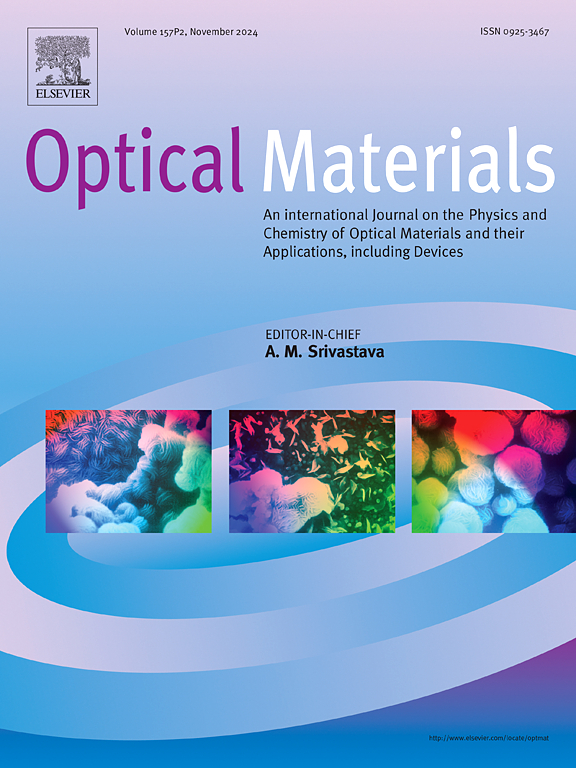化学沉积NbSe2薄膜中光学和材料特性的温度驱动调制
IF 3.8
3区 材料科学
Q2 MATERIALS SCIENCE, MULTIDISCIPLINARY
引用次数: 0
摘要
在室温、70℃和100℃条件下,全面研究了沉积温度对化学浴沉积NbSe2薄膜形貌、结构和光学特性的影响。NbSe2薄膜颜色随沉积温度变化明显;同时通过元素分析确认成分纯度。x射线衍射(XRD)显示NbSe2晶体的晶格参数为a = b = 3.446 Å和c = 12.55 Å, SEM和TEM分析表明,随着温度的升高,团聚减少,分散增强。FT-IR光谱证实了NbSe2硫族基团和其他官能团的特征,而拉曼光谱则强调了A1g模式的变化,表明在较高温度下层间键合更强,结构完整性增强。光学分析表明,直接带隙能从室温时的1.23 eV降低到100℃时的1.13 eV,同时乌尔巴赫能从0.13 eV降低到0.07 eV,表明结构有序性得到改善。结果表明,沉积温度对NbSe2薄膜的结晶度、形状和电学特性有重要影响。升高的温度增加了结构的完整性,减少了缺陷密度,增加了光学性能,因此建立了温度和材料性能之间的直接关联。带隙和乌尔巴赫能量的减小意味着电荷转移的增强,使这些薄膜适用于光电探测器、晶体管和能量存储应用。改进的分散进一步促进了它们在纳米级电气和传感应用中的应用,这些应用需要稳定性和均匀性。本文章由计算机程序翻译,如有差异,请以英文原文为准。
“Temperature-driven modulation of optical and materialistic properties in chemically deposited NbSe2 thin films”
The impact of deposition temperature on the morphological, structural, and optical characteristics of NbSe2 thin films deposited via chemical bath deposition at room temperature (R.T.), 70 °C, and 100 °C was comprehensively studied. The NbSe2 thin films exhibited distinct color variations correlated with deposition temperature; alongside compositional purity confirmed through elemental analysis. X-ray diffraction (XRD) revealed crystalline NbSe2 with lattice parameters a = b = 3.446 Å and c = 12.55 Å, while SEM and TEM analyses demonstrated reduced agglomeration and enhanced dispersion with increasing temperature. FT-IR spectra confirmed characteristic NbSe2 chalcogenide groups and additional functional groups, while Raman spectroscopy highlighted shifts in the A1g mode, indicating stronger interlayer bonding and enhanced structural integrity at higher temperatures. Optical analysis showed a decrease in direct bandgap energies from 1.23 eV at R.T. to 1.13 eV at 100 °C, with a concurrent reduction in Urbach energy from 0.13 eV to 0.07 eV, signifying improved structural order.
The results highlight the substantial influence of deposition temperature on the crystallinity, shape, and electrical characteristics of NbSe2 thin films. Elevated temperatures augment structural integrity, diminish defect density, and increase optical properties, so establishing a direct correlation between temperature and material performance. The decrease in bandgap and Urbach energy signifies enhanced charge transfer, making these films suitable for photodetectors, transistors, and energy storage applications. Improved dispersion further facilitates their use in nanoscale electrical and sensing applications, which require stability and homogeneity.
求助全文
通过发布文献求助,成功后即可免费获取论文全文。
去求助
来源期刊

Optical Materials
工程技术-材料科学:综合
CiteScore
6.60
自引率
12.80%
发文量
1265
审稿时长
38 days
期刊介绍:
Optical Materials has an open access mirror journal Optical Materials: X, sharing the same aims and scope, editorial team, submission system and rigorous peer review.
The purpose of Optical Materials is to provide a means of communication and technology transfer between researchers who are interested in materials for potential device applications. The journal publishes original papers and review articles on the design, synthesis, characterisation and applications of optical materials.
OPTICAL MATERIALS focuses on:
• Optical Properties of Material Systems;
• The Materials Aspects of Optical Phenomena;
• The Materials Aspects of Devices and Applications.
Authors can submit separate research elements describing their data to Data in Brief and methods to Methods X.
 求助内容:
求助内容: 应助结果提醒方式:
应助结果提醒方式:


